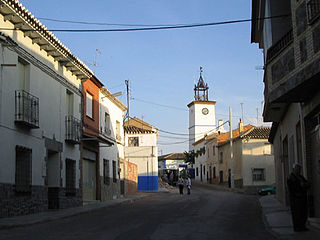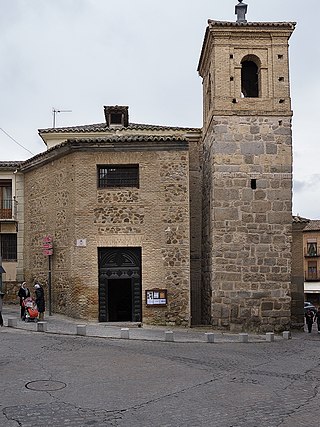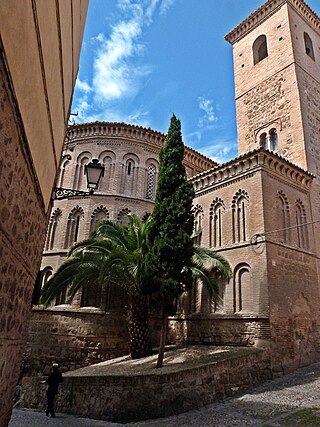
The Iglesia de la Magdalena is a church located in the city of Toledo, in Castile-La Mancha, Spain. Named after Mary Magdalene (one of the companions of Jesus), it was founded by Mozarabs during Muslim rule. [1]

The Iglesia de la Magdalena is a church located in the city of Toledo, in Castile-La Mancha, Spain. Named after Mary Magdalene (one of the companions of Jesus), it was founded by Mozarabs during Muslim rule. [1]
Its oldest documentary mention dates from 1153, and should have been in its beginnings a typical Mudéjar church. At present, the oldest part of the Church is the tower, which dates back to the 14th century and which initially stood as a separate structure. The church was later reformed in the 15th, 16th, 17th and 18th centuries, highlighting the Chapel of Nuestra Señora del Buen Suceso (now the Virgen del Amparo).
Located very close to the Alcázar and the Plaza de Zocodover, the church suffered in 1936 with harsh effects of bombing and fighting during the siege of the Alcázar. Several images were mutilated with blows and axes by Republicans. The most valuable loss was that of the famous Christ of the Waters, protagonist of an old legend.
The building was restored after the Civil War, but is no longer an active Roman Catholic church, and has been designated for the use of a restoration workshop. [2]

Toledo is a city and municipality of Spain, the capital of the province of Toledo and the de jure seat of the government and parliament of the autonomous community of Castilla–La Mancha.

Segovia is a city in the autonomous community of Castile and León, Spain. It is the capital and most populated municipality of the Province of Segovia. Segovia is in the Inner Plateau, near the northern slopes of the Sistema Central range and on a bend of the Eresma river.

Ciudad Real is a municipality of Spain located in the autonomous community of Castile–La Mancha, capital of the province of Ciudad Real. It is the 5th most populated municipality in the region.

La Magdalena Contreras is a borough in the Mexico City. As of the 2010 census, it has a population of 239,086 inhabitants and is the third-least populous of Mexico City's boroughs. It lies at an elevation of 2,365 m (7,759 ft) above sea level. It is named after two historically important communities—La Magdalena Atlitic and Colonia Contreras. The northern end of the borough is urbanized. The rest of Magdalena Contreras, with its mountains and ravines, is designated as a conservation zone. However, urban sprawl has put pressure on these conservation areas. In an effort to preserve the area's forests and natural resources, the borough government has started promoting ecotourism.

Úbeda is a municipality of Spain located in the province of Jaén, Andalusia. The town lies on the southern ridge of the so-called Loma de Úbeda, a table sandwiched in between the Guadalquivir and the Guadalimar river beds.

Alcázar de San Juan is a city and municipality of Spain located in the province of Ciudad Real, autonomous community of Castilla–La Mancha. It lies on the plain of La Mancha. From the 13th to the 19th century the history of Alcázar is strongly linked to the Grand Priory of the Order of St. John of Jerusalem. The city became a railway hub in the 19th century.

Cuéllar is a municipality in the Province of Segovia, within the autonomous community of Castile and León, Spain.

The Alcázar of Toledo is a stone fortification located in the highest part of Toledo, Spain. It is a large quadrangular building measuring 60 meters on a side, framed by four large towers 60 meters high, each crowned by the typical Madrid spire. Most of the building was rebuilt between 1939 and 1957 after the siege of the Alcázar during the Spanish Civil War.

Ciudad Colonial is the historic central neighborhood of the Dominican Republic's capital Santo Domingo. It is the oldest continuously inhabited European-established settlement in the Americas. The area has been declared a World Heritage Site by UNESCO. It is also known as Zona Colonial or more colloquially as "La Zona".

Santa Cruz, is the primary tourist neighborhood of Seville, Spain, and the former Jewish quarter of the medieval city. Santa Cruz is bordered by the Jardines de Murillo, the Real Alcázar, Calle Mateos Gago, and Calle Santa María La Blanca/San José. The neighbourhood is the location of many of Seville's oldest churches and is home to the Cathedral of Seville, including the converted minaret of the old Moorish mosque Giralda.

Camuñas is a municipality located in the province of Toledo, Castile-La Mancha, Spain. According to the 2018 census (INE), the municipality had a population of 1,740 inhabitants.

San Sebastian is a redundant church in Toledo, Spain. Originally a mosque, it was converted for use as church after the Reconquista. It is protected by the heritage listing Bien de Interés Cultural.

The Iglesia de El Salvador is a church in Toledo, Spain completed in 1159.

The Church of San Nicolás also known as the church of Church of San Nicolas de Bari, or the Church of San Nicolas de los Servitas, is a Catholic parish church in central Madrid, Spain.

The Church of San Bartolomé is a medieval building in Toledo, in Castile-La Mancha, Spain. It is located in the southern part of the walled city, at the corner of calle San Bartolomé and calle Cristo de la Para, a few hundred meters south-west of the Cathedral of Santa María.

The Church of St Leocadia is a medieval church located in Toledo, in Castile-La Mancha, Spain.

The Palace of Fuensalida, is a palace located in city of Toledo built at the end of the first half of the 15th century by Pedro López de Ayala, the first lord of Fuensalida, is a great example of the Toledan Mudéjar, a historical typology that is scarce in Toledo built heritage, where merge three styles: Gothic, Plateresque and Mudéjar.

The Museum of the Army is a military museum in Toledo, Spain, devoted to the history of the Spanish Army. It is one of the National Museums of Spain and it is attached to the Ministry of Defence.